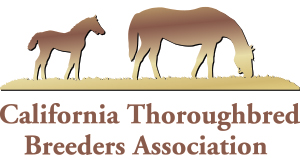By Jay Hovdey, DRF.com
COALINGA, Calif. (June 19, 2014) — The sights along Interstate 5 in California’s Central Valley near Fresno include almond orchards, cow pastures, and acres upon acres of barren agricultural ground, rendered fallow by the West’s terrible drought. There are hidden treasures, to be sure – a reservoir here, a winery there – but for the next month and a half, travelers on that stretch of highway will be oblivious to the real main attraction, with America’s most famous race horse living the life of Riley just a few miles off the main road.
California Chrome arrived Wednesday at the horse division of Harris Farms. The occasion marked one year, three months, and 13 days after General Manager Dave McGlothlin, farm trainer Per Antonsen, and the rest of the John Harris crew bade farewell to the white-trimmed chestnut with the wide blaze as a 2-year-old March 5, 2013, bound for the Hollywood Park stable of Art and Alan Sherman. McGlothlin recalls they had high hopes for the colt, but as it turned out, they were aiming low.
With victories in the Santa Anita Derby, the Kentucky Derby, and the Preakness for owners Perry Martin and Steve Coburn, California Chrome became the toast of the racing world, and he lost no respect going for the Triple Crown but finishing in a dead heat for fourth in the Belmont Stakes, less than two lengths behind the winning Tonalist. While fair-weather fans might have jumped ship, California Chrome remains the most popular West Coast-based racehorse since Zenyatta.
Sherman and the owners had a brief holiday in mind for California Chrome, even before he entered the starting gate for the June 7 Belmont. The fact that he emerged from the race a tired horse with a nasty cut on his right front heel had nothing to do with Sherman’s judgment a break away from the track was in order. After all, California Chrome had been in nothing but steady training and racing for 15 solid months.
Alan Sherman, who made the trip Wednesday to Harris, was reluctant to let go of California Chrome’s shank. They had been through a lot together, navigating the tricky waters of a Triple Crown played out far from their Los Alamitos home.
“I’m sure I’ll be up here looking in on him more than a few times,” the younger Sherman promised.
In the meantime, McGlothlin’s team will be doting on California Chrome as they would a visitation of royalty.
“He’s grown up quite a bit since we last had him here, but he looks great,” McGlothlin said.
The “letting down” of a Thoroughbred racehorse such as California Chrome requires a step-by-step process designed to wean him from the pressures of the racetrack.
“At first, he’ll be hand-walked a couple of times a day,” McGlothlin said Thursday. “We took him out into one of the stallion paddocks this morning and let him graze on the shank for a few minutes before putting him back in his stall. We’ll do it again this afternoon and then every day for the next week or so. When it looks like he is finally relaxed enough and not overly concerned about the activity or lack of activity going on around him, then we’ll move him out to a paddock where he can be out most of the day.”
California Chrome is a thinker, possessed of a heightened awareness that can be found in many top competitors. In a horse of questionable emotional stability, such traits can lead to fretful behaviors. They sense threats in every new sight, sound, and smell. By contrast, California Chrome has displayed an admirable ability to treat the world around him as curiously entertaining. He should love summer camp.
Still, he won’t be thrown into the deep end. A horse set free after a year and a half of close confinement can do himself harm. McGlothlin said before he is turned loose, California Chrome will be given regular walking tours of his paddock to find the fences, the water, and the best patches of grass. On the day the shank comes off, he will be given a dose of a sedative under the supervision of Harris Farms resident vet Jeanne Bowers.
“He’ll probably just stand in place,” McGlothlin said. “Then, as the sedation wears off, he’ll move about more and more and finally come to the party. Hopefully it will only take a couple of times before he’s comfortable with his new environment and not agitated at all. He’ll realize it is very relaxing, that there’s nothing going on he needs to be concerned about.”
So let California Chrome be a regular horse for a while – a highly pampered, multi-million-dollar asset of a horse – and let the trainer do the worrying.
“You always hesitate a little turning them out like that,” Art Sherman said. “A trainer never likes to lose sight of his horse for very long, but that’s just trainers, I guess. There’s always a chance something could happen at the farm, though.”
Just like there’s always a chance something could happen at the track?
“You got that right,” Sherman replied.
So let’s stipulate that there is always a chance something could happen to a Thoroughbred anywhere you put him. Such is the nature of the breed. Sherman hopes the month and a half at Harris will clear the competitive residue from California Chrome’s head and he will return to training in August a happy, healthy warrior, ready to pick up where he left off.

